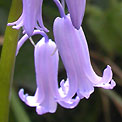Native bluebell, Hyacinthoides non-scripta

Other common names: Auld man's bell, blâklocka, calverkeys, campainha, campanula, campanule, campánula, campanilla, culverkeys, common bluebell, engelska klockhyacint, English bluebell, glockenblume, harebell, klokje, jacinth, jacinthe des bois, jacinthe sauvage, jacinto, ring-o'-bells, sternhyazinthe, wild hyacinth, wilde hyacint, wood bells, wood hyacinth, ying guo lan zhong hua.
Other scientific names: various, including Endymion non-scripta, Hyacinthus non-scripus, Scilla non-scripta and Scilla nutans.
Description

Bluebells are perennial herbs growing from a bulb.
The basal leaves are few in number (3-6) per bulb. The leaves may be between 20-45cm long and 7-25mm wide and are erect at first but become floppy and spread across the ground later in the season. Leaves are usually linear to linear-lanceolate in outline and usually have an acute tip. The leaves are smooth, shiny and slightly succulent.
The flower spike is usually 20-50cm high, with the flowers arranged in a raceme that droops or nods distinctly to one side. Each raceme usually has between 4 and 16 flowers.
Each flower has two linear-lanceolate bracts, one usually longer than the other, at the base of the flower stalk. The flower stalk is normally 3-10mm long. The flowers hang down to one side of the main stem. The flowers are usually deep violet-blue but paler blue forms (rarely white and very rarely pink) do occur. Each flower is made up of six petals that are fused together at the base to form a narrow straight-sided bell. Flowers are normally 10-28mm in diameter and each petal is usually 14-20mm long. The petals are usually rolled back.
The three inner stamens are three quarters of the length of the three outer stamens, or less. The filaments of the outer stamens are attached to the petal for about four fifths of their length. The anthers are pale cream. Flowers are usually strong and sweetly scented, particularly on warm days.

Origin and Distribution
Bluebells are often frequent in ancient woodlands, hedgerows, under bracken and sea cliffs. They are especially frequent in western and upland areas. Although found across the British Isles Bluebells are rare or absent in some areas including parts of East Anglia, western Ireland, northern Scotland, the Orkneys, Shetlands and the Western Isles. Bluebell also occurs as an escape from cultivation, particularly near towns and cities.
